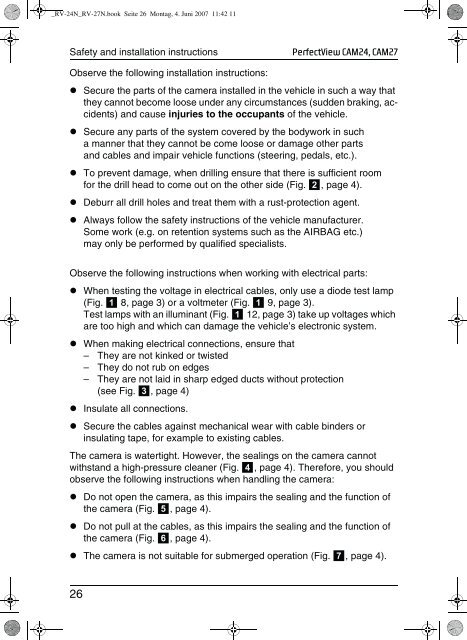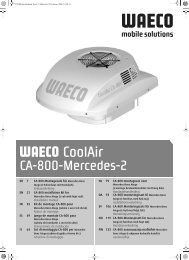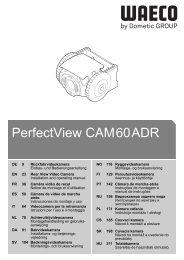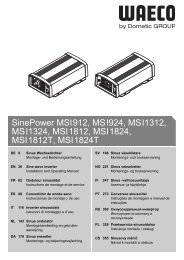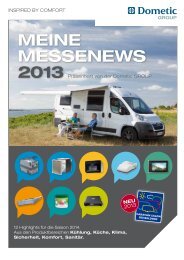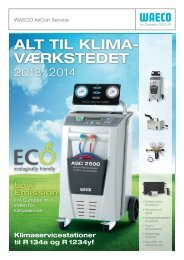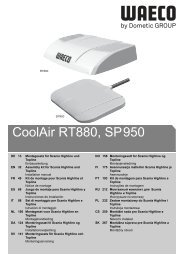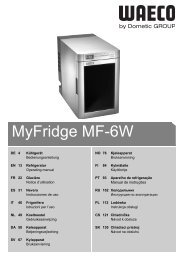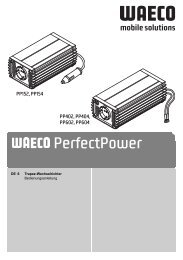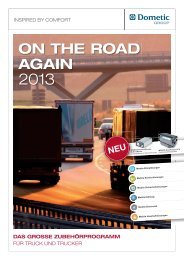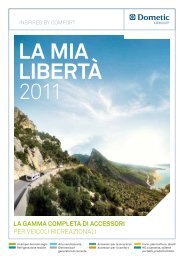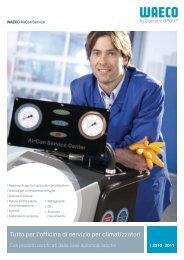PerfectView CAM24, CAM27 - Waeco
PerfectView CAM24, CAM27 - Waeco
PerfectView CAM24, CAM27 - Waeco
You also want an ePaper? Increase the reach of your titles
YUMPU automatically turns print PDFs into web optimized ePapers that Google loves.
_RV-24N_RV-27N.book Seite 26 Montag, 4. Juni 2007 11:42 11<br />
Safety and installation instructions<br />
<strong>PerfectView</strong> <strong>CAM24</strong>, <strong>CAM27</strong><br />
Observe the following installation instructions:<br />
• Secure the parts of the camera installed in the vehicle in such a way that<br />
they cannot become loose under any circumstances (sudden braking, accidents)<br />
and cause injuries to the occupants of the vehicle.<br />
• Secure any parts of the system covered by the bodywork in such<br />
a manner that they cannot be come loose or damage other parts<br />
and cables and impair vehicle functions (steering, pedals, etc.).<br />
• To prevent damage, when drilling ensure that there is sufficient room<br />
for the drill head to come out on the other side (Fig. 2, page 4).<br />
• Deburr all drill holes and treat them with a rust-protection agent.<br />
• Always follow the safety instructions of the vehicle manufacturer.<br />
Some work (e.g. on retention systems such as the AIRBAG etc.)<br />
may only be performed by qualified specialists.<br />
Observe the following instructions when working with electrical parts:<br />
• When testing the voltage in electrical cables, only use a diode test lamp<br />
(Fig. 1 8, page 3) or a voltmeter (Fig. 1 9, page 3).<br />
Test lamps with an illuminant (Fig. 1 12, page 3) take up voltages which<br />
are too high and which can damage the vehicle’s electronic system.<br />
• When making electrical connections, ensure that<br />
– They are not kinked or twisted<br />
– They do not rub on edges<br />
– They are not laid in sharp edged ducts without protection<br />
(see Fig. 3, page 4)<br />
• Insulate all connections.<br />
• Secure the cables against mechanical wear with cable binders or<br />
insulating tape, for example to existing cables.<br />
The camera is watertight. However, the sealings on the camera cannot<br />
withstand a high-pressure cleaner (Fig. 4, page 4). Therefore, you should<br />
observe the following instructions when handling the camera:<br />
• Do not open the camera, as this impairs the sealing and the function of<br />
the camera (Fig. 5, page 4).<br />
• Do not pull at the cables, as this impairs the sealing and the function of<br />
the camera (Fig. 6, page 4).<br />
• The camera is not suitable for submerged operation (Fig. 7, page 4).<br />
26


